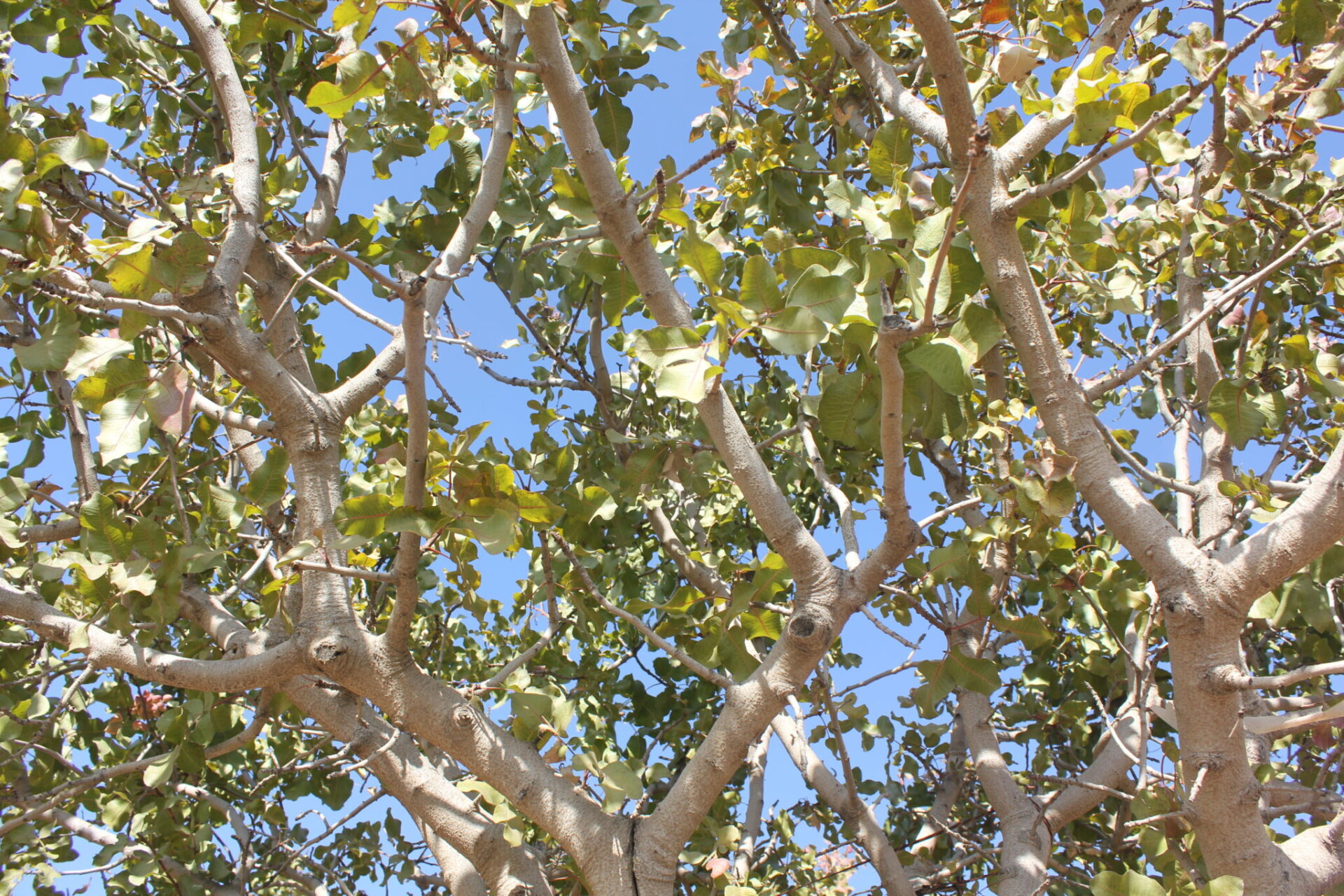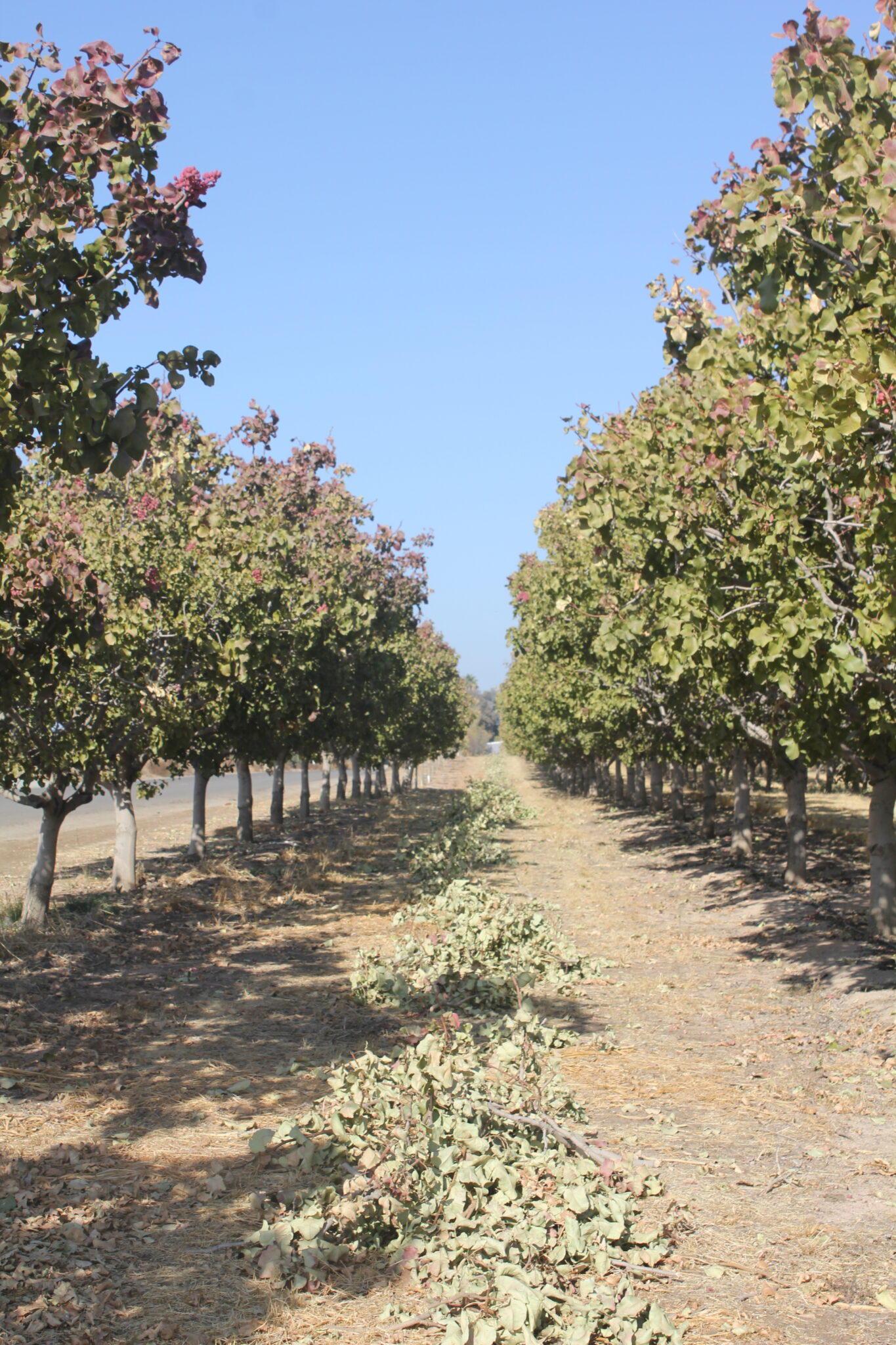
There are two reasons to train and prune a tree: to facilitate orchard operations, primarily harvesting, and to produce annual quality crops by controlling alternate bearing.
For the first five years in the ground, canopies are being trained with a mixture of heading and training cuts; the objective is a tree that eventually intercepts maximum light infiltrating the canopy. When trees begin to produce a harvestable crop in years six through eight and full bearing, pruning helps maintain a canopy that intercepts maximum light and produces efficiently harvestable annual quality yields.
Beginning at years six through eight, a pistachio tree benefits from canopy management to capture light and facilitate photosynthesis, keeping the tree trunk accessible to harvest equipment without contacting the branches, controlling canopy height and volume, directing branch and shoot orientation, and producing new bearing surfaces, all with net profit in mind.
“Quality, harvestable yield—how much net return per square foot of orchard floor—should drive canopy management,” said Louise Ferguson, UC Davis Department of Plant Sciences and a long-time researcher in pistachio production. Ferguson’s presentation on canopy management was part of UCCE’s annual Pistachio Short Course.
“The major reason for pruning a mature tree is to produce harvestable annual yields,” Ferguson said.
An ideal, efficiently harvestable canopy is compact and upright, under 15 feet in height. The trunk is accessible to the shaker head, scaffolds are upright, short and stiff, and do not interfere with one another or contact the harvester. Trunk shaking transmits force best vertically, less well horizontally and poorly in a downward direction. Therefore, harvest is more efficient on upright branches closer to the trunk axis. Research done by UC engineers and Ferguson demonstrated most nut removal occurs within the first six seconds of shaking. Shaking will not increase harvester efficiency, but pruning to direct branch growth upward, having the crop closer to the tree axis and removing flat branches will.
Hand Pruning
Canopy management, specifically a combination of mechanical and hand pruning, can also be used to produce good quality annual crops and control alternate bearing.
Canopy management can be done by hand or mechanically, but Ferguson noted that even with mechanical topping and hedging, some hand pruning is needed. The advantage of hand pruning is precision. Disadvantages include high cost of labor, time and difficulty teaching correct technique. Mechanical pruning is less expensive and decreases alternate bearing, but cuts are indiscriminate. Although hand pruning is better horticulturally, the decision to use either method of canopy management must be based on sustainability and economics.
Hand pruning for canopy management requires some basic knowledge and understanding of the right tools for the job. Hand pruners must know the difference between fruiting bud and vegetative bud, and recognize the transition on a branch. They must also know the crop is borne on one-year-old wood and understand the apically dominant growth habit of the pistachio tree. And they must know the difference between a heading and thinning cut, and the response from each. Hand pruners must also recognize the tree shape desired.
Ferguson outlined four steps in hand pruning canopy management with hand tools. The first step, using loppers and saw, is removal of low, flat overlapping broken branches that won’t shake. These are thinning cuts. Second, outside thinning cuts are used to push the canopy up and closer to the tree by thinning branches growing outward using loppers and pole pruners. The third step is performing inside thinning cuts with loppers and saw, the on-productive ‘snakes’ that grow up through a tree, branch at the top and block light in the canopy. Finally, whips at the top of the canopy are tipped using pole pruners; these are the heading cuts.
Mechanical Pruning
Mechanical pruning uses annual topping to control tree height in every other row, every other year hedging for light interception. If needed for light interception and air circulation, every-other-row middle cross hedging can also be done. Mechanical pruning should be followed by limited hand pruning, specifically steps two and three detailed in the hand pruning directions above; thinning cuts to remove low flat branches that do not shake well and interfere with the harvester and thinning cuts within the canopy center, the ‘snakes’ that block light.
Ferguson cited retired UCCE Kings County Farm Advisor Bob Beede’s mechanical pruning trial conducted from 2012 to 2017. The data reaffirmed an earlier trial’s demonstration that mechanical pruning can mitigate alternate bearing in trees on an Atlantica rootstock by topping and hedging before the low crop year. Beede’s trial had Kerman scions on seedling rootstocks, such as P. atlantica, Atlantica; P. integerrima, PG1; P. integerrima x P. atlantica PGII; and P. atlantica x P. integerrima, UCB1.
Beede’s data demonstrated an interaction between rootstock and mechanical pruning that affected alternate bearing. First, alternate bearing was most severe in the trees on the following rootstocks in this order: Atlantica, PGI, PGII and UCBI. In trees on seedling Atlantica and PGI rootstocks, alternate bearing was decreased by about 50% with mechanical topping and hedging before the low crop year.
Trees on the hybrid seedling PGII and UCBI rootstocks had much lower alternate bearing (about 60% lower) than trees on the seedling Atlantica and PGI rootstocks, and the timing of topping and hedging, before the on or off year, had no effect on the severity of alternate bearing. This suggests the vigor imparted by the hybrid rootstocks has the ability to mitigate the individual shoot level alternate bearing in the Kerman scion. However, the rootstock does not affect the bud abscission within an individual shoot that produces alternate bearing when the shoots on a tree synchronize. Rather, it appears the rootstock and the mechanical pruning produce a more even ratio of fruiting to non-fruiting shoots within a canopy, decreasing the tree’s alternate bearing.
Timing and Cuts
Timing of pruning mature trees for canopy management is important. It is important that dormant pruning be done before the lateral bud break suppressing plant hormone, auxin, is produced in the apical bud. When the apical bud begins to break dormancy, auxin is released and starts suppressing bud break of lateral buds. Auxin is a hormone that is a control chemical used to obtain food and or nutrients. Auxins are produced in the stem, buds and root tips to maintain apical dominance. They also enforce dormancy of lateral, sub-terminal, vegetative buds. Removing apical buds stops the auxin distribution that inhibits lateral vegetative bud break. This means pruning should be done before the apical bud begins to break dormancy.
Heading cuts, Ferguson explained, are when the shoot is cut in half and the basal portion with fewer buds remains. A heading cut removes stored carbohydrates, subtending and proximal shoot growth, and alters the carbohydrate to bud ratio, encouraging vegetative bud break of the remaining buds and producing branching and new fruit bearing growth. Thinning cuts remove the entire shoot at the base. There is less of a response from the tree, and the canopy is thinned, allowing more light penetration. A thinning cut enhances subtending shoot growth, forcing the canopy upward.
The cost differential between hand and combined hand and mechanical pruning is approximately 50%.
Ferguson concluded with stating she will never argue that hand pruning is horticulturally better, or that larger trees produce higher yields. But she noted that mature tree canopy management is just that: management. Decisions should be made on the basis of logistics, when and how you can successfully get your orchard pruned during the dormant season, how it affects efficiently harvestable yield, and the net return.
















